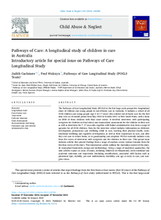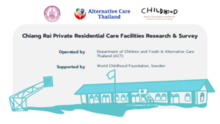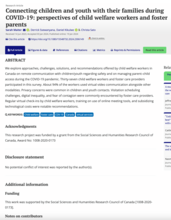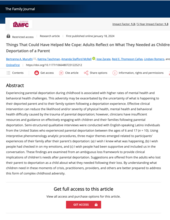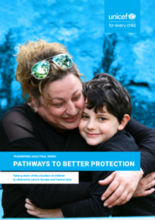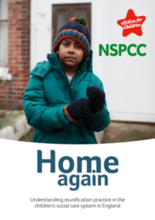Displaying 301 - 310 of 10392
Norwegian youth in out-of-home care move three times as frequently as their peers. Such placement instability is linked to negative outcomes in terms of social attachment, well-being, educational achievements, health, and future opportunities. Norway implemented a new child welfare service reform in 2022 that increased the municipalities responsibilities for out-of-home care. This study evaluates how the implemented measures affect the number of moves within out-of-home care in Trøndelag county. Norway.
The Pathways of Care Longitudinal Study (POCLS) is the first large-scale prospective longitudinal study of children and young people in out-of-home care in Australia. It includes a cohort of all 4126 children and young people (age 0 to 17 years) who entered out-of-home care for the first time over an 18-month period from May 2010 to October 2011 in New South Wales, with a focus on 2828 of these children with final court orders.
This is a summary of every private residential care facility in the Chiang Rai Province of Thailand, including institutional care homes, children’s homes, and residential schools. This summary provides an extensive and useful data set for those interested in the reform of private children's homes.
This is a summary of children's homes in the Chiang Mai Province of Thailand over the last 1.5 years. The research team visited a total of 371 private children's homes. This summary provides an extensive and useful data set for those interested in the reform of private children's homes.
The authors explore approaches, challenges, solutions, and recommendations offered by child welfare workers in Canada on remote communication with children/youth regarding safety and on managing parent–child access during the COVID-19 pandemic.
This report presents findings from qualitative interviews conducted with English-speaking Latino individuals from the United States who experienced parental deportation between the ages of 6 and 17 years old. They offer suggestions about what they needed following their loss as a child. By understanding what children need in these moments of crisis, practitioners, providers, and others are better prepared to address this form of complex childhood adversity.
This article explores how the monitoring of foster homes in Norway is experienced by children and youths who have been exposed to what they consider abusive behaviour by foster parents. Using a thematic narrative theoretical framework, the article shows that a common narrative in the youths’ accounts is a story of mistrust towards social workers and monitoring officers, which relates to a general mistrust towards the child welfare service.
This report provides an in-depth analysis of the situation of children in alternative care and in adoption in Europe and Central Asia (ECA) based on available data from TransMonEE, as well as other sources such as MICS, DataCare and the Conference of European Statisticians (CES). It marks the first analysis of data on children in alternative care by the UNICEF ECA Regional Office since the publication of the ‘At home or in a home’ report in 2010, highlighting the developments and challenges in collecting and reporting data on children in alternative care and adoption and summarises recommendations derived from recent data review initiatives.
Young people who age out of state care are at risk of a range of negative outcomes. In England, national data provides only five indicators of care leavers’ lives and there are no measures of how young people themselves feel about their transition to adulthood. To fill this gap a new survey to measure subjective wellbeing was coproduced with 31 care leavers. The survey was then distributed by 21 local authorities and completed by 1804 care leavers.
Understanding reunification practice in the children’s social care system in England


